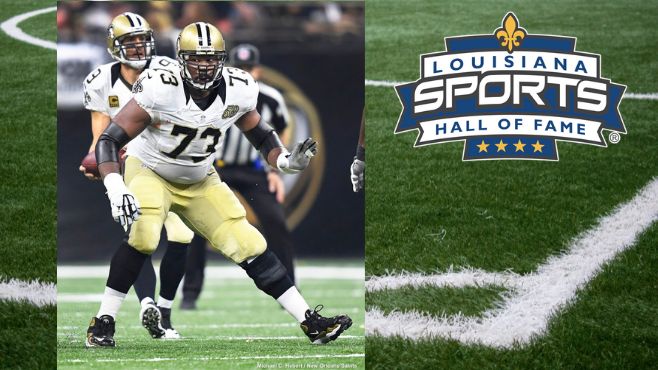
Doug Marrone remembers the first game of Jahri Evans’ NFL career.
It was a preseason contest against the Tennessee Titans and star defensive tackle Albert Haynesworth, one of the most feared defenders in the NFL at the time.
Marrone coached offensive tackles at the University of Tennessee in 2001, when Haynesworth developed into a heralded first-round draft pick for the Volunteers. He knew how dominant Haynesworth could be when he put his mind to it.
“I remember telling Jahri, ‘This guy is a career killer,’” Marrone said. “’If you don’t go in and play well against him you can have problems.’”
Evans’ response caught his coach by surprise.
“Jahri was, like, ‘Who is he? What number is he?’” Marrone said.
Marrone remembers thinking that his wet-behind-the-ears rookie left guard was in for a rude awakening. But when the whistle blew for that Aug. 12, 2006 game, Evans more than held his own against Haynesworth, sending a message not only to his teammates and coaches but to the rest of the NFL that the stage was not too big for the unheralded rookie from Division II Bloomsburg University. Evans belonged.
“From that point on, we knew we had something special,” Marrone said.
Evans started all 16 games for the NFL’s top-ranked offense in 2006 and was voted to the All-Rookie Team. For the next 11 years, he was a fixture at right guard for one of the most prolific offenses in NFL history and became one of the most decorated linemen in franchise history. This year, he punctuated his stellar career by earning induction into the Louisiana Sports Hall of Fame.
The Induction Celebration featuring Evans and 11 other inductees is June 23-25 in Natchitoches. Participation opportunities and information is available at LaSportsHall.com or by calling 318-238-4255.
“When I got drafted by the Saints in ’06, I wanted to be the best player I could be, so I always kept working and trying to improve,” Evans said. “We had a great general behind us for all those years in Drew Brees, and we broke a lot of records and won a lot of games. He made our jobs very easy.”
How Evans ended up in New Orleans was largely the result of great scouting and good fortune.
Evans was an overlooked recruit at Frankford High School in northeast Philadelphia. He was recruited by Maryland, Virginia Tech, Vanderbilt and others as a junior, but the interest dissipated after he fractured his kneecap while playing pickup basketball the following summer and missed his senior season of football.
Bloomsburg took a flyer on him at the recommendation of one of his teammates, Sean Williams. Evans earned a partial football scholarship and also qualified for an academic scholarship, without which he might not have been able to afford the school. Evans graduated in the top 10 of his class thanks to the prodding of his single mother, Katreen Hopkins, who stressed academics to Evans and his three older sisters.
At Bloomsburg, Evans redshirted as a freshman to gain strength and mature into his body. By his sophomore year, he was one of the best linemen on the team, rotating at both guard and tackle spots before taking over at left tackle. During his junior and senior seasons, he was a finalist for the Division II Gene Upshaw Offensive Player of the Year award.
Pro scouts took note during his senior season, but many had reservations because of Bloomsburg’s run-heavy offensive attack and the quality of the opposition.
“You had no problem saying that this guy could be a good run blocker at this (NFL) level,” Marrone said. “What you didn’t know, because of a lack of evidence, was: ‘does he have the ability to pass protect at this level?,’ which is always probably the biggest question mark from college to pro.”
Evans was one of seven Division II players invited to the NFL Scouting Combine that year. He performed well in the drills and aced his interviews.
“I remember (other players) saying, ‘I’m going to wait until my pro day (to do certain drills),’ and I was, like, ‘well, there’s no tomorrow for me,’ ” Evans said. “’I don’t have a Pro Day. There’s nobody coming to Bloomsburg to watch me,’ so I had to do everything.”
The Saints, though, had seen enough to have Evans on their radar.
“When the tape came in on Jahri, it kind of came in on a horse and buggy,” Saints coach Sean Payton joked. “You had one copy of it, and we wanted to hold on to that tape, thinking no one else in the league might have the same copy and we saw what a good football player he was.”
When the draft rolled around, the Saints had Evans graded as a solid second day choice. They wanted to draft Wisconsin tight end Owen Daniels with their first pick on the second day of the 2006 NFL Draft. With the second pick of Round 2, they were in great position to get their man. The Houston Texans, though, beat them to the punch, nabbing Daniels with the first pick, No. 33 overall.
Undeterred, the Saints quickly pivoted to Plan B. Because of Evans’ relatively low profile, they were confident they could land him lower in the draft, so they orchestrated a trade with the Cleveland Browns, which netted them center Jeff Faine and the No. 43 pick in Round 2, which they used to select Alabama safety Roman Harper.
They then took aim at Evans. The Saints had an “in” with Evans. College scout Jim Manos’ father was the offensive coordinator at Bloomsburg and knew Evans was a Division I talent. He knew Evans had landed at Bloomsburg solely because of his untimely injury and touted Evans’ athleticism, work ethic and character to the staff.
The Saints were able to swap fourth-round picks with the Eagles and acquire run-stuffing nose tackle Hollis Thomas in the deal. The Saints selected Evans with the 108th overall pick. In Faine, Harper, Evans and Thomas, the Saints essentially acquired four starters for the price of the Nos. 34 and 99 overall picks.
The Saints planned for Evans to back up veteran Jermane Mayberry at right guard, but Mayberry retired after suffering a shoulder injury during training camp. The Saints threw Evans into the starting lineup between a pair of veterans, Faine, and right tackle Jon Stinchcomb, and he thrived.
“When you get a player from a smaller school like Bloomsburg, you really don’t know how the transition is going to be,” Payton said. “But with Jahri, it was immediate.”
From 2006 through 2013, Evans started 122 consecutive games, including playoffs. A reliable force on one of the league’s most dominant offensive lines, he missed only nine of 202 games in his career. The Saints perennially ranked among the NFL’s best offenses and Brees was annually among the league’s least sacked quarterbacks over that period
Evans earned six Pro Bowl invitations and a franchise-record four first-team All-Pro honors, twice as many as Pro Football Hall of Fame tackle Willie Roaf. He was voted onto the NFL’s All-2010s Team and was elected into the Saints Hall of Fame in 2020.
“He was one of the most physical guards in the league,” Stinchcomb said. “He had just incredible upper-body strength, good lower-body bend, and just a tenacity that let him finish better than 99 percent of the guards that played.”
Indeed, Marrone called Evans the best finisher that he’s ever coached, a player so gifted athletically that he could block defenders even when he was technically unsound or out of position.
Former Saints offensive line coach Aaron Kromer said Evans’ footwork, hand technique, strength and intelligence were all above average for a starting NFL lineman. His agility, in particular, was special for a player of his massive size – 6-feet-4, 318 pounds.
The Saints took advantage of Evans’ extraordinary athleticism by having him pull as a lead blocker on run plays and sending him into the flat to clear a path downfield on screen passes.
In the 2009 NFC Championship game, Evans was the lead blocker on both of running back Pierre Thomas’ touchdowns in the Saints’ 31-28 overtime win over Minnesota, one a 38-yard screen pass, the other an 8-yard run behind Evans.
In Super Bowl XLIV two weeks later, Evans laid a key block on Colts linebacker Gary Brackett on another screen pass to spring Thomas for a 16-yard touchdown catch.
“He’s one of the toughest and smartest players I have ever been around in coaching and that coupled with his unselfishness and dependability made him one of the most respected players in our locker room,” Payton said
Zach Strief started alongside Evans on the Saints offensive line for six seasons from 2011 to 2016. He called Evans the most poised and confident player he ever played with, someone who personified the traits Saints coaches and scouts sought in players during the unprecedently successful Payton-Brees era.
“When we prepared for the draft, Sean asked the same questions about every single player we evaluated: ‘Is he tough? Is he smart. Does he love football? And is he a great teammate?’” said Strief, who now serves as the team’s assistant offensive line coach. “There are few players in the history of this organization that have encompassed those four things more than Jahri Evans.
“For 11 years, I watched Jahri dominate the best football players in the world. He was an absolutely dominant player.”
Today, Evans is living in the Philadelphia suburb of Wyndmoor and manages his various business interests, including a restaurant, fitness facility, drinking water company and various real estate investments. He also conducts a weekly sports talk radio show with his longtime agent Jerrold Colton. He’s going to be at Saints training camp as a special assistant, invited by new coach Dennis Allen.
But first, he and his family are here in Natchitoches as he takes a place among the state’s all-time greats in all sports.
“It’s a huge honor and not one that I expected,” Evans said of the Hall of Fame recognition. “Being honored by the state of Louisiana is special when you consider the number of great athletes that have come out of the state. I’m happy, fortunate, blessed and honored to be a part of it.”
Written for the LSWA by Jeff Duncan.

